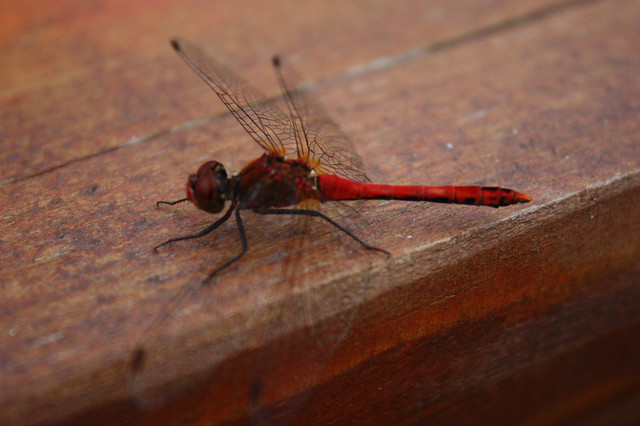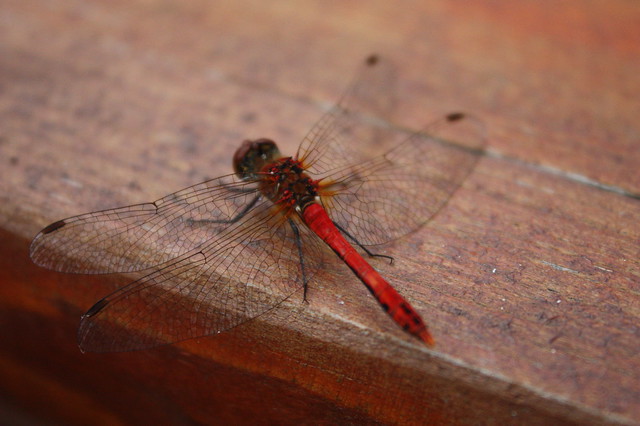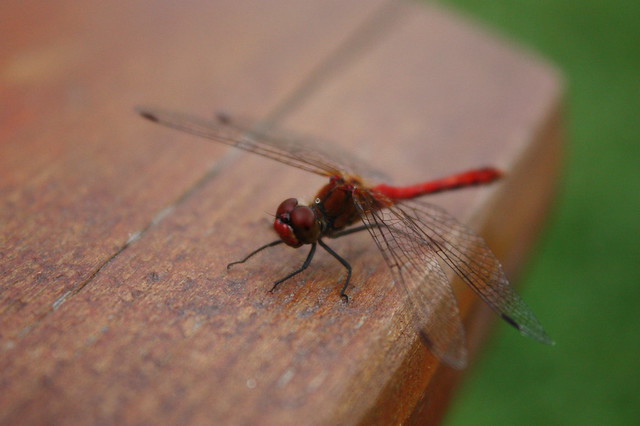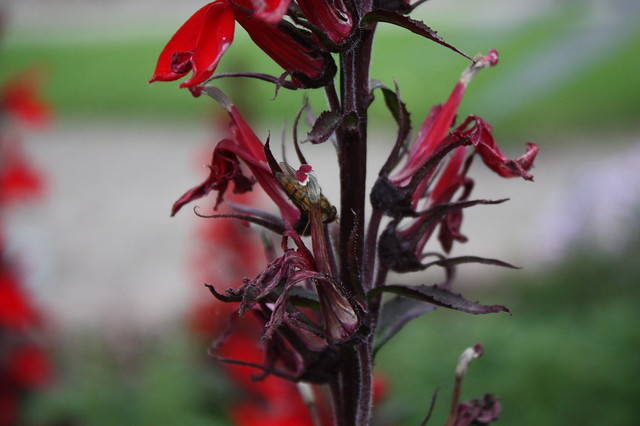Showing posts with label Species. Show all posts
Showing posts with label Species. Show all posts
Daisies in Meadow, Two
It's rather amazing how, in certain parts of the world, daisies are taken for granted without a second thought. We pass them in trails, stamp on them on grass. They seem to have become backdrops - the pretty, little pieces of scenery that are always just there, like a patch of luscious grass in the shallowest days of temperate summer, before the heat has set in and begun to dry. We don't see them until they're not there.
I have stated my affinity for grass before, and I share a similar love for these flowers. The only difference is in the effect they have on me: they are the clearest reminder of those warm, sunny, energetic days. They remind me of what I'm missing in winter, and remind me to enjoy the always-too-narrow period of summer bliss.
How do they make you feel?
(The exact species of this specimen is, in my layman opinion, Leucanthemum vulgare.)
Bed of Rudbeckia hirta
On the Flickr page of the yellow flowers in this post, I said that I believed them to be Rudbeckia hirta. Now, they don't look very much like these ones, but, evidently, variation is quite high between cultivars. In any case, I have more faith that this one is R. hirta than the previous one. Tentatively, at least.
Malva sylvestris, Flower, Close-Up
The flower on the left is what the right one will turn to as it ages, although, it, too, is beginning to wither. Besides looking pretty, Malva sylvestris is a fairly versatile plant. You can eat the leaves, raw or cooked, using the young ones as a lettuce substitute, while the flowers can be used to garnish your salad.
M. sylvestris can also be used for medicinal purposes. According to Plants For a Future (linked above), "All parts of the plant are antiphlogistic, astringent, demulcent, diuretic, emollient, expectorant, laxative, salve." The website also provides sources for these claims, which you can find in the "Links / References" section.
Sources:
http://www.pfaf.org/user/Plant.aspx?LatinName=Malva+sylvestris
http://en.wikipedia.org/wiki/Malva_sylvestris#References
http://upload.wikimedia.org/wikipedia/commons/a/a5/Flower_poster_2.jpg
Disclaimer: Plants are living things. The Number Zero and all associated parties do not advocate killing plants, whether for ingestive, medicinal, recreational, or any other use. Killing plants is plant murder. The Number Zero and all associated parties acknowledge that killing plants is plant murder. In detailing the various methods of which one can dispose a murdered plant, The Number Zero is merely providing information and not endorsing these methods. By reading this, you are agreeing that The Number Zero and all associated parties will not be held liable for any misconduct that results from your reading of this article when the anti-vegetarians come and get you.
Sympetrum sanguineum Set
Side, One:
Back, One:
Download original.
Download original.
Side, Two:
Download original.
Okay, first, an error on my part: I originally identified this as the Sympetrum fonscolombii, or Red-veined Darter. Unfortunately, I was too zealous with that classification. While S. fonscolombii has yellow-striped legs, eyes with a blue/grey underside, lack of waist, and pale pterostigma, this specimen has none of those things. How could I confuse it for a Red-veined Darter! (Yes, it's not even a question.)
So, what species, then, is it? I believe it is the Ruddy Darter (Sympetrum sanguineum). The British Dragonfly Society says this about S. sanguineum:
Intense orange colouration at base of wings: check.
Brown pterostigma: check.
Two prominent black marks on S8 and S9: check.
Noticeable constriction of the abdomen (i.e. waist) around S4: check.
Now, we do need to base classifications on more than appearance, things like behaviour, habitat, and diet, but as we can't do any of those things (minus habitat, which is also confirmed), my tentative conclusion is that this specimen is indeed the Ruddy Darter, S. sanguineum. I want to add, however, that, as always, I'm not a taxonomist or entomologist. If you are and think I got this wrong, please point me in the correct direction.
Both S. fonscolombii and S. sanguineum are commonly found in their range and doing well, according to the IUCN Red List (source here and here), and while for S. sanguineum that includes northwestern Europe, S. fonscolombii has only started encroaching on that area recently. According to Habitas, it was seen in Ireland (specifically in Cavan) as early as the 1940's, but only started being seen annually in Britain in 1995.
Sources:
http://www.british-dragonflies.org.uk/species/red-veined-darter
http://www.british-dragonflies.org.uk/species/ruddy-darter
http://www.iucnredlist.org/apps/redlist/details/60038/0
http://www.iucnredlist.org/apps/redlist/details/158691/0
http://www.habitas.org.uk/dragonflyireland/5647.htm
http://www.habitas.org.uk/dragonflyireland/5650.htm
http://www.odesforbeginners.com/ID101/dragon_abdomen.aspx
So, what species, then, is it? I believe it is the Ruddy Darter (Sympetrum sanguineum). The British Dragonfly Society says this about S. sanguineum:
This species is smaller than the Common Darter. The legs are entirely black. An intense orange colouration can be seen only at the very base of the wings. The pterostigma is brown. There are usually two prominent black marks on S8 and S9.
The males become blood-red with maturity with a red frons and red-brown thorax. There is a very noticeable constriction of the abdomen around S4, giving a club-shaped appearence.Black legs: check.
Intense orange colouration at base of wings: check.
Brown pterostigma: check.
Two prominent black marks on S8 and S9: check.
Noticeable constriction of the abdomen (i.e. waist) around S4: check.
Now, we do need to base classifications on more than appearance, things like behaviour, habitat, and diet, but as we can't do any of those things (minus habitat, which is also confirmed), my tentative conclusion is that this specimen is indeed the Ruddy Darter, S. sanguineum. I want to add, however, that, as always, I'm not a taxonomist or entomologist. If you are and think I got this wrong, please point me in the correct direction.
Both S. fonscolombii and S. sanguineum are commonly found in their range and doing well, according to the IUCN Red List (source here and here), and while for S. sanguineum that includes northwestern Europe, S. fonscolombii has only started encroaching on that area recently. According to Habitas, it was seen in Ireland (specifically in Cavan) as early as the 1940's, but only started being seen annually in Britain in 1995.
Sources:
http://www.british-dragonflies.org.uk/species/red-veined-darter
http://www.british-dragonflies.org.uk/species/ruddy-darter
http://www.iucnredlist.org/apps/redlist/details/60038/0
http://www.iucnredlist.org/apps/redlist/details/158691/0
http://www.habitas.org.uk/dragonflyireland/5647.htm
http://www.habitas.org.uk/dragonflyireland/5650.htm
http://www.odesforbeginners.com/ID101/dragon_abdomen.aspx
Episyrphus balteatus on Red-Flowered Plant
Our old friend, the mistaken bee. I've got to be short with this one, because we're leaving soon for the second part of the Cynic, Live odyssey. I reflected earlier today that I felt seeing them so soon again may be a detriment to the entire experience because the previous one hasn't really settled in, yet, but we're taking these opportunities where we can get 'em. Who knows when we'll see them again?
Episyrphus balteatus on Small, White Flowers, Four
The intricacy of this plant is reminiscent of a snowflake. The flowers grow from a stem that grows from a stem, itself, and that stem grows from yet another one. Actually, come to think of it, it's also reminiscent of this.
(Update on my demolished Broncos fandom: I'm still not over it.)
Episyrphus balteatus on Small, White Flowers, Three
The best view of the insect, and proof that it isn't, again, a bee. It's funny how easy it is to mistake it for one, and yet, how easy it is to realise it isn't when you just focus for a moment. (Well, that's why you're meant to think before reaching a conclusion.)
Episyrphus balteatus on Small, White Flowers, Two
The line of focus is so thin, that even the Episyrphus balteatus is blurred. The blending of colours the blur creates adds a nice dimension, though.
Episyrphus balteatus on Small, White Flowers, One
This looks like the Small, White Flowers I posted earlier this month, and it may very well be the same species, but both plants differ in one significant way (to me, anyway): this one curves upward, while the other one curved downward.
Episyrphus balteatus on Bamboo Leaves
Remember that little creature? It's a type of fly that mimics the look of a bee. I actually didn't notice it until very recently, which shows just how attentive I can be.
Taxus baccata
Talk about lucky... I had originally thought this was some type of Fir, because of the leaf structure, but was shaken off by the red "fruit". I'm no expert, but I've never seen a Fir with red cones that look like berries. I checked Wikipedia (too lazy to check with more legit channels), and sure enough, couldn't find anything. So, in the end, I just settled on something generic...
...well, not quite. Me being the post-modern unmyself I am, I decided to click up a page before closing the tab, and what do you know, I find this. That's exactly what I was looking for! Taxus baccata it is. Close, but definitely not a Fir.
Microtus agrestis, Eating, Three, Four, & Five
Well, as promised, the final batch. I saved the best (in my opinion) for last, so I hope you enjoy them and enjoyed meeting our little friend of the woodland floor.
You can find more information on the short-tailed vole here:
Wikipedia
ARKive
The Mammal Society
USGS
Microtus agrestis, Failures
Before we move on to the final batch of Microtus agrestis pictures, I just want to show again the difficulty in photographing it (noobs gotta learn someway). The trick was always to get the focus on the right spot - the vole - but finding that sweet spot as it was darting around, or even eating, was surprisingly hard. Nevertheless, a few of those failures turned out to be kinda cool.
Note the tiny green leaf in the corner of the third image!
Microtus agrestis, Eating, One & Two
Eventually, we gave it some of our food, and it happily started chomping on it.
Microtus agrestis, Foraging, Two
I'm kinda surprised that its feet are so big, even it's partly an illusion because the toes are spread apart. Considering the diverse terrain it travels over, though, this revelation does make sense.
I also love the fact that its poking its nose through the leafy crevasses, just because of the cute factor. Did I mention the cute factor, yet? I did? Oh.
Microtus agrestis, Foraging, One
Finally, we get a good look. Talk about cute! And what a star for putting up with the prodding camera as long as it did.
The last picture is what made me see that it was a short-tailed vole (Microtus agrestis). When I found a similar-looking species, I thought I'd finally found the right name, but then I saw the tail and realised it was actually the wrong one, as mine had a long tail. Then, to confirm this, I checked that image, and --
Good thing I took a picture. My memory isn't as reliable.
Microtus agrestis, Blurred
Our little friend was quick and shifty. Getting good shots, as you can see here, was tricky at times. Fortunately, there were moments where it settled down for long enough to get a still.
(*self-congratulatory pat on the back* for eventually finding the exact species. Good thing I didn't settle on tree shrew as I originally intended.)
Episyrphus balteatus on Yellow Flower, Two
Unfortunately, I don't have the exact name of the flower. May get it eventually, but I am surprisingly horrible at identifying plants.
Episyrphus balteatus on Yellow Flower, One
I first thought this was a bee, but then I noticed that it didn't really look that much like a bee, beyond the bands. I think it's actually a Episyrphus balteatus (99% sure), and you can check the veracity of my claim with this image.
Flowers at Night, Five, Six, & Seven
Download original.
Download original.
Well, that's it for this series. We end with a group of vivid flowers. I have to do a double-take when I see these three pictures; their subjects are all spectacularly beautiful.





































